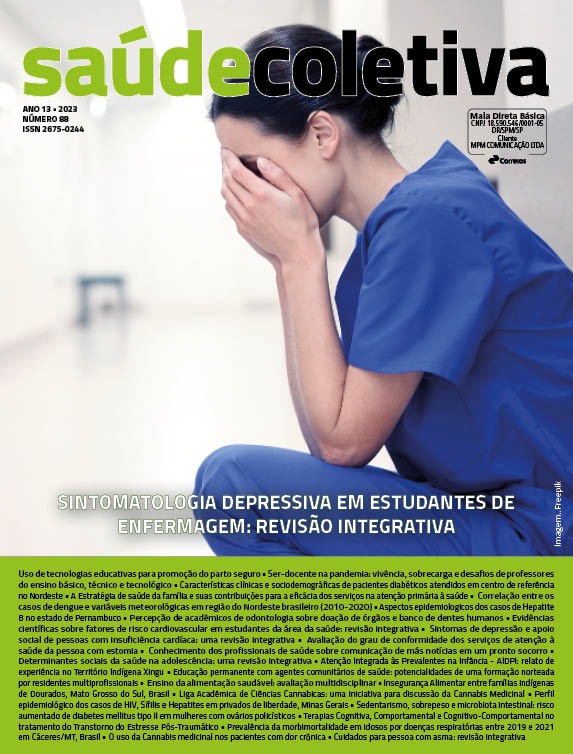SAÚDE FUNCIONAL DE TRABALHADORES EM FASE DE REABILITAÇÃO POR LOMBALGIA CRÔNICA E A CONDIÇÃO DE CINESIOFOBIA E DO CAPITAL PSICOLÓGICO
DOI:
https://doi.org/10.36489/saudecoletiva.2023v13i88p13518-13533Palavras-chave:
Dor lombar crônica, capacidade funcional, cinesiofobia, autoeficácia, esperança, resiliência e otimismoResumo
Objetivo: Analisar se há relação entre o capital psicológico e cinesiofobia em pacientes com dor lombar crônica de um Núcleo de Reabilitação de Trabalhadores. Métodos: estudo de campo, exploratório descritivo e quantitativo com abordagem transversal, em trabalhadores formais e informais de ambos os sexos, idades entre 29 a 67 anos, com dor lombar crônica. O projeto foi apreciado e aprovado pelo Comitê de Ética em Pesquisa (CEP) da Universidade do Extremo Sul Catarinense, com o número 5.821.064. Utilizando as triagens do Núcleo de Reabilitação de Trabalhadores; aplicado um questionário referente a questões sociodemográficas, comportamentais e de trabalho; a Escala de Tampa para Cinesiofobia avaliar grau de cinesiofobia; e a Escala do PsyCap Abreviado versão traduzida e validada para a língua portuguesa, envolvendo o Capital Psicológico, para avaliar as 4 capacidades. Resultados: A intensidade dolorosa associada a cinesiofobia apresentou significativa relação entre esses dois fatores. A média da cinesiofobia na dor intensa foi maior do que na dor moderada. No entanto não houve resultados significativos na associação do capital psicológico e intensidade dolorosa neste estudo. Conclusão: Os objetivos iniciais de averiguar a relação entre os dois fatores do estudo não foram alcançados, acredita-se que esta limitação se deve ao número baixo de pacientes com dor lombar crônica atendido pelo Núcleo de Reabilitação de Trabalhadores, todavia pode-se afirmar que o capital psicológico está associado a níveis de satisfação, desenvolvimento e bem-estar relacionado ao ambiente organizacional de modo geral, e que pacientes com dor lombar apresentam nível moderado de cinesiofobia e quando associado a dor, possuem um grau de dor intensa.
Referências
Sato EM, Magalhães MO, Jenkins BC, da Silva Ferreira L, da Silva HAR, Farias Furtado PR, et al. Lombalgia em Idosos de Belém-Pa, Brasil: Prevalência e Associação com Incapacidade Funcional. Saúde 2021;9:1658. https://doi.org/10.3390/healthcare9121658. DOI: https://doi.org/10.3390/healthcare9121658
Rech, EF. Qualidade de vida e bem-estar: estudo em uma empresa do setor industrial. 2018. Trabalho de Conclusão do Curso. Universidade Federal da Fronteira Sul, Cerro Largo (RS). Orientador: Rodrigo Prante Dill.
Trocoli, TO.; Botelho, RV. Prevalência de ansiedade, depressão e cinesiofobia em pacientes com lombalgia e sua associação com os sintomas de lombalgia. Revista Brasileira de Reumatologia, 2016 jul; 56 (4): 330-336. DOI: https://doi.org/10.1016/j.rbr.2015.09.009
Lopez-Nuñez, MªI, JESÚS, SN, VISEU J, SANTANA-CÁRDENAS S. Capital Psicológico dos Trabalhadores na Espanha. Análise Fatorial Confirmatória do PCQ-12. Revista Iberoamericana de Diagnóstico y Evaluación - e Avaliação Psicológica, 2017 jul; 3(48): 67-79, DOI: https://doi.org/10.21865/RIDEP48.3.06
Suarez, AL, Calderon JM, Falla D. Papel da cinesiofobia na dor, incapacidade e qualidade de vida em pessoas que sofrem de dor musculoesquelética crônica: uma revisão sistemática. British Journal Of Sports Medicine; 2018 abr; 53 (9): 554-559.
Santos LG, Madeira K, Longen WC. Prevalence of Self-Reported Spinal Pain in Brazil: results of the national health research. Coluna/Columna [Internet]. 2017Jul;16(3):198–201. Available from: https://doi.org/10.1590/S1808-185120171603165890 DOI: https://doi.org/10.1590/s1808-185120171603165890
Araujo JA, Campos MR, Santos MVF dos, Gonçalves DA, Mari J de J, Tófoli LF, Ballester D, Fortes S. Dor lombar e transtornos mentais comuns na Estratégia Saúde da Família: uma associação pouco reconhecida. Rev Bras Med Fam Comunidade [Internet]. 17º de setembro de 2018 [citado 21º de junho de 2023];13(40):1-14. Disponível em: https://rbmfc.org.br/rbmfc/article/view/1740 DOI: https://doi.org/10.5712/rbmfc13(40)1740
Silva MC da, Fassa AG, Valle NCJ. Dor lombar crônica em uma população adulta do Sul do Brasil: prevalência e fatores associados. Cad Saúde Pública [Internet]. 2004Mar;20(2):377–85. Available from: https://doi.org/10.1590/S0102-311X2004000200005 DOI: https://doi.org/10.1590/S0102-311X2004000200005
Filho OMC, Araújo KLRC; LOMBALGIA CRÔNICA: PREVENÇÃO, DIAGNÓSTICO E TRATAMENTO NA ATENÇÃO PRIMÁRIA. Acervo UNASUS. 2020 out. Disponível em: https://ares.unasus.gov.br/acervo/handle/ARES/18964
Swinkels-Meewisse EJ, Swinkels RA, Verbeek AL, Vlaeyen JW, Oostendorp RA. Psychometric properties of the Tampa Scale for kinesiophobia and the fear-avoidance beliefs questionnaire in acute low back pain. 2003 Fev;8(1):29-36. doi: 10.1054/math.2002.0484. PMID: 12586559. DOI: https://doi.org/10.1054/math.2002.0484
Lustosa LP, Goulart A, Silvério FJ. Dor lombar crônica e cinesiofobia: impacto no desempenho funcional. Revista Terapia Manual. 2011 mar; 9(42): 114-118.
Luthans, F. et al. Positive psychological capital: measurement and relationship with performance and satisfaction. Personnel Psychology. 2007; 60 (3): 541-572, DOI: https://doi.org/10.1111/j.1744-6570.2007.00083.x
Azanza, G, África JD, Juan AM, Fernando JM. Capital psicológico positivo: Validación del cuestionario PCQ en España. Anales de Psicología. 2014 ; 30 (1): 294-301. Disponível em: https://revistas.um.es/analesps/article/view/analesps.30.1.153631/156551. DOI: https://doi.org/10.6018/analesps.30.1.153631
Antunes AC, Caetano A, Pina-Cunha M. Reliability and construct validity of the Portuguese version of the Psychological Capital Questionnaire. Psychological Reports. 2017; 120 (3): 520-536. Disponível em: https://journals.sagepub.com/doi/10.1177/0033294116686742. DOI: https://doi.org/10.1177/0033294116686742
Martins, M. C. F. et al. Escala de Capital Psicológico: adaptação brasileira da ecp12. In: CONGRESSO LUSO-BRASILEIRO DE PSICOLOGIA DA SAÚDE, 2., 2011, São Bernardo do Campo. Anais [...]. São Bernardo do Campo, 2011. p. 1-2.
Kamei, H. et al. Questionário de Capital Psicológico - Versão Reduzida (QCP-12): evidências de Validade da Versão Brasileira. Psico-USF. 2018 jun; 23 (2): 203-214,
Luthans, F.; Youssef, C.; Avolio, B. Psychological capital: developing the human competitive edge. New York: Oxford University Press, 2007 DOI: https://doi.org/10.1093/acprof:oso/9780195187526.001.0001
Bandura, A. Self-Efficacy: toward a unifying theory of behavioral change. Psychological Review, Washington. 1977; 84 (2):191-215. Disponível em: https://www.academia.edu/3331051/selfefficacy_toward_a_unifying_theory_of_behavioral_change. DOI: https://doi.org/10.1037//0033-295X.84.2.191
Longen, WC. Ginástica Laboral na Prevenção de LER-DORT? Um estudo reflexivo em uma linha de produção (Dissertação), Florianópolis (SC): UFSC, 2003.
Silva, M. Z.; Aandrade, A. L. Influência da Carreira e do Capital Psicológico em Aspectos de Vida e Trabalho. Psico-USF, Campinas- São Paulo, v.24, n. 1, p. 55- 67, 2019. Disponível em: https://www.scielo.br/j/pusf/a/yvQR5XnnvmSX34gtC7rwzRk/?lang=pt#:~:text=Hist% C3%B3rico-,Resumo,(satisfa%C3%A7%C3%A3o%20com%20a%20vida DOI: https://doi.org/10.1590/1413-82712019240105
Costa Branco J, Felin Cerezer M, Bonaldo Rezende G, Saibt Martins J, Soares Vieira I. PREVALÊNCIA DE CINESIOFOBIA E FATORES ASSOCIADOS EM INDIVÍDUOS COM DOR LOMBAR. Saúde (Sta. Maria) [Internet]. 28º de junho de 2021 [citado 21º de junho de 2023];47(1). Disponível em: https://periodicos.ufsm.br/revistasaude/article/view/64786 DOI: https://doi.org/10.5902/2236583464786
Lustosa, Lygia Paccini; Goulart, André; Silverio, Francisco José. Dor lombar crônica e cinesiofobia: impacto no desempenho funcional. Terapia Manual, 9(42):108-113, 2011.
Crombez, Geert et al. Pain-related fear is more disabling than pain itself: evidence on the role of pain-related fear in chronic back pain disability. Pain, v. 80, n. 1, p. 329-339, 1999. DOI: https://doi.org/10.1016/S0304-3959(98)00229-2
Elias, Juliana; Longen, Willians C. Classification of low Pain Into Subgroups for Diagnostic and Therapeutic Clarity. Coluna/Columna, v.19, 2020. 34-39 https://doi.org/10.1590/S1808-185120201901206442 DOI: https://doi.org/10.1590/s1808-185120201901206442







